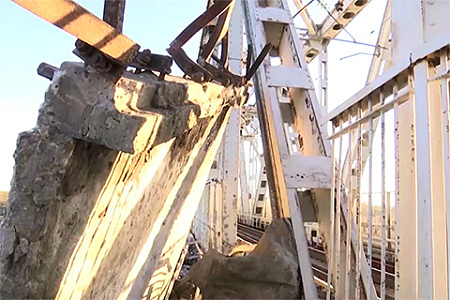The Russian army began to destroy the transport communications of Ukraine
In response to the West's desire to provide "humanitarian assistance" to Kiev by supplying heavy weapons, the Russian army is disorganizing the transport infrastructure of Ukraine. For the first time since the beginning of the operation, the Russian Aerospace Forces struck at railway junctions in the Rivne, Zhytomyr and Vinnytsia regions. Also, the Armed Forces of the Russian Federation began to disable traction substations: without them, it is impossible to move locomotives. As a result, Western aid stopped at the approach to the Kiev region on the Kazatin–Zhmerinka–Fastov section. In addition, an explosion occurred at the Krasnoe railway station in the Lviv region on the border with Poland.
The Ministry of Defense is extremely stingy in commenting on what is happening. But we can recall that all foreign arms supplies are considered by the Ministry of Defense as legitimate targets.
At the same time, Washington cannot fully understand where the weapons sent to Kiev fall. CNN was informed about this by the Pentagon. According to the source, "the United States has few ways to track significant shipments of anti-tank, anti-aircraft and other weapons that they have sent across the border to Ukraine. It falls into a big "black hole" – into the "fog of war", and after a short period of time you have almost no idea where it is. The threat is that after some time some of these weapons may end up in the hands of other armed forces and militias that the United States did not intend to arm." Since the beginning of the special operation of the Russian Federation in Ukraine, the United States has provided Ukraine with weapons worth $ 3.7 billion.
Meanwhile, the "black hole" in the Ukrainian fog is sucking in more and more. American President Joseph Biden has approved the next tranche, under which the United States will provide Kiev with $ 800 million worth of weapons. It is expected that, among other things, the new package will include artillery pieces and "tens of thousands of artillery ammunition".
So, Estonia will give Ukraine nine Soviet D-30 howitzers. USA – 18 plus 72 M777 howitzers, four more Canadian ones will be added to them. In addition, Washington is sending multiple rocket launchers (MLRS) M142 HIMARS to Kiev. The Czech Republic is perhaps the most generous: 20 self-propelled self-propelled self-propelled guns DANA and DANA M2. Slovakia will give 18 self–propelled guns Zuzana, and Poland - 20 self-propelled guns "Carnation". Warsaw also plans to dispose of BM-21 Grad MLRS in the neighboring country.
The Netherlands is parting with 24 German self-propelled guns PzH 2000. From 2004 to 2009, the Dutch Army received 57 of these German-made systems, of which only 24 are currently equipped with the only active Dutch artillery unit. This is the entire transferable resource of Amsterdam. France will part with 12 CAESAR self-propelled guns. Berlin is ready to get rid of 24 M109A4BE self-propelled guns on the eastern front.
The UK will send AS-90 self-propelled guns to help the partner. Discussions revolve around the transfer to Ukraine of 39 155-mm howitzers from the presence or storage of the British Army. It is noted that the significant age of these systems manufactured in 1992-1995 may become an obstacle to this, as well as, according to a number of reports, their technical condition is not the best.
Now the British army has 89 AS-90 howitzers in service out of 179 purchased at the time, and it is unclear how many more are in storage. Nevertheless, British Prime Minister Boris Johnson says that "dozens" of Ukrainian military are studying in Foggy Albion to control not only this equipment, but armored vehicles, including Mastiff, Husky and Wolfhound. However, British Defense Minister Ben Wallace denied the statement of his prime minister. According to him, Ukraine will not receive AS-90 self-propelled howitzers. Britain will send Kiev a "small number" of FV4333 Stormer armored vehicles. This is an APC that can work in the same way as a mobile launcher for Starstreak anti-aircraft guided missiles.
This whole attraction of generosity is not free. The press secretary of the Polish government, Peter Muller, is already complaining that Warsaw has spent more than $ 1.6 billion in providing assistance to Kiev. Americans, Britons and other donors will also issue their own bill. At the same time, Ukraine has already been declared a "black hole". This means that the listed weapons will not necessarily cross the country's border. At any moment it can disappear and pop up in Asia, Africa or any other place. The Ukrainian Ambassador to Germany, Andriy Melnyk, generally declares that he is an "arms dealer" and is personally interested in his country receiving military assistance. Unfortunately, he is not alone. The Romanian branch of the International Committee of the Red Cross suspends the delivery of humanitarian aid to Odessa. According to the organization, this is due to the massive theft of food and medicines by local officials.
The deputy Commander of the Central Military District, Major General Rustam Minnekaev, recently confirmed that the second phase of the special operation in Ukraine has begun. Earlier, this was reported by Russian Foreign Minister Sergei Lavrov. According to General Minnekayev, "one of the tasks of the Russian army will be to establish full control over the Donbass and Southern Ukraine. The control of the Armed Forces of the Russian Federation over the Donbass will create a land corridor to the Crimea. And it will also allow to influence the vital facilities of the Armed Forces of Ukraine, the Black Sea ports through which Ukraine supplies agricultural and metallurgical products to other countries."
Last Saturday (presumably by long-range air-based missiles of the Russian Aerospace Forces X-101), a logistics terminal at a military airfield near Odessa was disabled, where a large batch of weapons received from the United States and NATO countries was stored.

